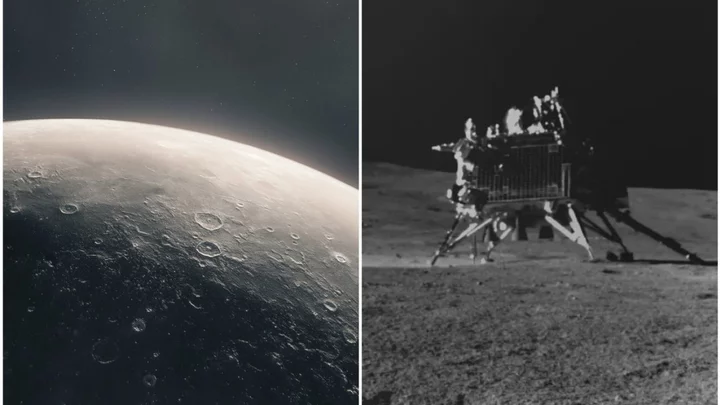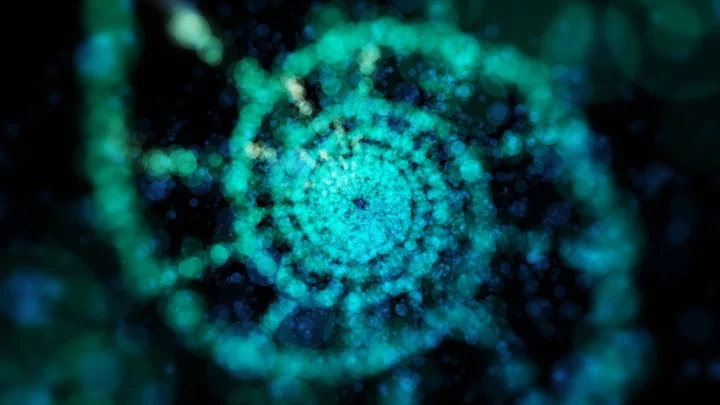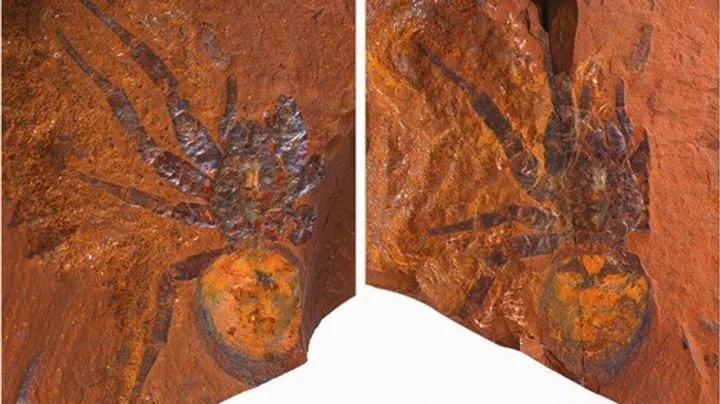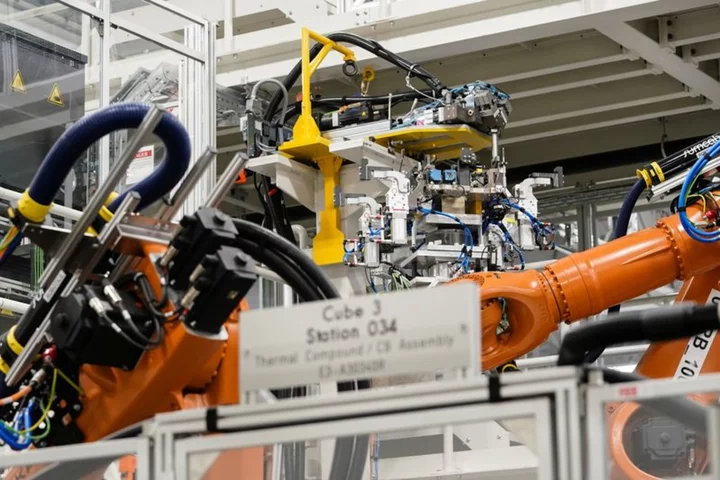
10 Haunting Dark Tourism Destinations From Around the World
From Auschwitz to the 9/11 Memorial & Museum, these dark tourism destinations are fascinating—and definitely not for the faint of heart.
2023-09-26 00:15

NBA 2K24 Update 1.3 Patch Notes: Full List of Changes
The NBA 2K24 update 1.3 patch notes are here with changes to MyCAREER mode, dunking, defense, and more, set to hit the game in October.
2023-09-25 23:55

New language discovered in ancient Bronze Age ruins
Ancient clay tablets unearthed from ancient ruins in Turkey by archaeologists have revealed a language lost to the passages of time. The new language was discovered in the ancient capital of the Hittite Empire at Hattusa (known as Boğazköy-Hattusha). The well-preserved tablets are among many incredible artworks found at the site - a UNESCO World Heritage Site. Over the past four decades, researchers have dusted off nearly 30,000 unique tablets - with most written in Hittite. New research, however, shows that some of the tablet haul shows that they are written in a language previously unknown to modern man. Of course, the meaning and words of this language have not been deciphered, but it appears from early inspection to branch off from languages used within the Hittite Empire - and is being referred to as Kalašma. Interestingly though, researchers from the Istanbul Department of the German Archaeological Institute have noted that the new language is found within a recitation in a 'cultic ritual text'. While that's usually the basis of a middling horror movie, we're certain that there's nothing to worry about - it stems from an ancient Hittite practice. Professor Daniel Schwemer explains that the discovery wasn't unexpected. "The Hittites were uniquely interested in recording rituals in foreign languages," he said. These ritual texts provide insight into little-known languages, and thanks to this discovery, one more has been added to the list. Sign up for our free Indy100 weekly newsletter Have your say in our news democracy. Click the upvote icon at the top of the page to help raise this article through the indy100 rankings.
2023-09-25 23:27

Chandrayaan-3 makes 'unexpected' discovery on the Moon
India’s Chandrayaan-3 lander only touched down on the Moon a month ago, but already it's made some major contributions to science. The spacecraft arrived on the satellite's unexplored south pole on 23 August, securing India's place as the first country to achieve this ambitious feat. Its rover, named Pragyan (or "wisdom" in Sanskrit) then embarked on an exploration of the rocky terrain, equipped with two instruments for conducting chemical experiments. And now, India's space agency, the ISRO, has published the ground-breaking data collected by the bold robot. Pragyan's findings offered a new, detailed insight into what makes up the lunar soil. And whilst scientists were unsurprised by the presence of iron, titanium, aluminium and calcium in the rocks, they were stunned to note a much higher concentration of sulphur than expected. The discovery is significant for a number of reasons. Most significantly, perhaps, because the sulphur could be used to help create a human base on the Moon. As Jeffrey Gillis-Davis, a planetary scientist, pointed out in a piece for Science Alert: "Astronauts and robots could travel from the south pole base to collect, process, store and use naturally occurring materials like sulfur on the Moon – a concept called in-situ resource utilization. "In-situ resource utilization means fewer trips back to Earth to get supplies and more time and energy spent exploring. Using sulfur as a resource, astronauts could build solar cells and batteries that use sulfur, mix up sulfur-based fertilizer and make sulfur-based concrete for construction." Gillis-Davis went on to explain that sulfur-based concrete has a number of advantages over the more common variety used in building, pointing out that it "hardens and becomes strong within hours rather than weeks, and it's more resistant to wear". "It also doesn't require water in the mixture, so astronauts could save their valuable water for drinking, crafting breathable oxygen and making rocket fuel," he added. The presence of sulphur near the Moon's south pole also suggests that highland soils at the lunar poles could have very different compositions to highland soils at the lunar equatorial regions. This would have key implications for our understanding of how the Moon works as a geological system, given that sulfur mainly comes from volcanic activity. Still, there's plenty of work to be done. And while this is all just one small step in Chandrayaan-3's mission, it could mean a great leap in how we view our dear celestial companion. Sign up for our free Indy100 weekly newsletter Have your say in our news democracy. Click the upvote icon at the top of the page to help raise this article through the indy100 rankings.
2023-09-25 23:26

Scientists believe alien life could exist under 'impossible' conditions
Scientists have found that one of the key pillars of theory around how life works – that it depends on carbon – may not be the case on other planets. Here on Earth, life depends on organic compounds which are composed of carbon, and often involve other elements such as sulphur, oxygen, hydrogen, nitrogen and phosphorus. With organic compounds, life is partly sustained by chemical interactions called autocatalysis, which are self-sustaining. That means they produce molecules which then enable the reaction to happen again, and do not need any outside influence to keep going on. In the new study, scientists looked for autocatalysis in non-organic compounds. The theory is that if autocatalysis helps drive a process called abiogenesis – the origin process for life – then this origin process could also come from non-organic matter. Betül Kaçar, an astrobiologist, bacteriologist and evolutionary biologist at the University of Wisconsin-Madison, told news outlet Space.com: “It's important to explore these possibilities so that we have an idea of what all forms of life can look like, not just Earth life.” "One of the major reasons that origin-of-life researchers care about autocatalysis is because reproduction — a key feature of life — is an example of autocatalysis. “Life catalyses the formation of more life. One cell produces two cells, which can become four and so on. “As the number of cells multiply, the number and diversity of possible interactions multiplies accordingly.” The scientists searched in a huge trove of existing scientific documents for examples of autocatalysis, and found 270 different cycles of the reactions. Most of the 270 examples did not feature organic compounds, but rather elements which are rare in life forms such as mercury, or the radioactive metal thorium. “It was thought that these sorts of reactions are very rare,” Kaçar said in a statement. “We are showing that it's actually far from rare. You just need to look in the right place.” Now, it means scientists can test these cycles to get a better understanding of how autocatalysis can work. “The cycles presented here are an array of basic recipes that can be mixed and matched in ways that haven't been tried before on our planet,” said study author Zhen Peng, also an evolutionary biologist at the University of Wisconsin-Madison. “They might lead to the discovery of completely new examples of complex chemistry that work in conditions where carbon- or even silicon-based cycles are too either combusted or frozen out.” The scientists published their findings in the Journal of the American Chemical Society. Sign up to our free Indy100 weekly newsletter Have your say in our news democracy. Click the upvote icon at the top of the page to help raise this article through the indy100 rankings.
2023-09-25 23:21

OpenAI's ChatGPT will 'see, hear and speak' in major update
OpenAI's ChatGPT is getting a major update that will enable the viral chatbot to have voice conversations with
2023-09-25 22:56

Scientists find 'giant' dinosaur spider fossil in Australia
If you thought Australia’s spiders were scary, wait until you see the prehistoric version. Scientists have found a fossilised giant trapdoor spider in New South Wales, only the fourth specimen of its kind to be found in Australia. The creature would have roamed and hunted in the surrounding areas which were once a lush rainforest, researchers said in a recently filed report. Last year, scientists unearthed fossils of the rainforest area from millions of years ago, teeming with specimens including plants, trapdoor spiders, giant cicadas and wasps. Now the area is a grassland region known as McGraths Flat. Researchers have named the spider fossil ‘Megamonodontium mccluskyi’. It would have lived in the Miocene period 11m to 16m years ago. “Only four spider fossils have ever been found throughout the whole continent, which has made it difficult for scientists to understand their evolutionary history,” said palaeontologist Matthew McCurry of the University of New South Wales and the Australian Museum. “That is why this discovery is so significant, it reveals new information about the extinction of spiders and fills a gap in our understanding of the past. “The closest living relative of this fossil now lives in wet forests in Singapore through to Papua New Guinea. “This suggests that the group once occupied similar environments in mainland Australia but have subsequently gone extinct as Australia became more arid.” The spider was found among many other Miocene fossils. In some of them, the fossils were so well preserved that subcellular structures could be made out. “Scanning electron microscopy allowed us to study minute details of the claws and setae on the spider's pedipalps, legs and the main body,” said virologist Michael Frese of the University of Canberra. The details meant scientists could confidently place it near the modern Monodontium, or trapdoor spider. However, it is five times larger than its modern day relatives. Megamonodontium mccluskyi's body is 23.31 millimetres long – that is just over an inch. The discovery of the species also tells us something of the past climate of Australia, the report added. The fact that it was found in a layer of rainforest sediment means the region was once much wetter than it is now. That could, in turn, help scientists understand how a warming climate has already altered the country’s life forms – and how it might change them again. "Not only is it the largest fossilized spider to be found in Australia but it is the first fossil of the family Barychelidae that has been found worldwide," said arachnologist Robert Raven of Queensland Museum. "There are around 300 species of brush-footed trapdoor spiders alive today, but they don't seem to become fossils very often. "This could be because they spend so much time inside burrows and so aren't in the right environment to be fossilized." The findings were published in the Zoological Journal of the Linnean Society. Sign up to our free Indy100 weekly newsletter Have your say in our news democracy. Click the upvote icon at the top of the page to help raise this article through the indy100 rankings.
2023-09-25 22:22

Mercedes applies for tax relief for projects at two U.S. plants
BERLIN German carmaker Mercedes-Benz has applied for tax breaks for potential projects at two of its U.S. plants
2023-09-25 22:20

Google Pixel 8 camera will include ‘creepy’ face-changing AI
Google’s next flagship smartphone will feature an AI-powered camera that can automatically alter the expression on someone’s face, according to a leaked video. The Google Pixel 8 and Google Pixel 8 Pro, which are set to be unveiled on 4 October, have already been partially revealed by the US tech firm, which has a habit of teasing its devices before the official release date. The latest promo video, posted by reliable leaker Kamila Wojciechowska, shows Pixel 8 users radically adjusting the appearance of photo subjects “with a tap”. “Reimagine an image with Magic Editor from Google Photos,” the video states. “It’ll make you wonder, can a phone be made of magic? Nope, it’s AI.” The video generated excitement among Pixel owners on social media, though some expressed concern about the camera’s abilities. “I am sold on the Pixel 8 series,” one user of X, formerly Twitter, posted. “The head swap kinda creepy though.” Similar to Apple with its latest iPhone 15 series, the tech giant is expected to place a major emphasis on the phone’s camera, with other leaks and rumours surrounding Google’s next Pixel devices suggesting both versions will feature a 50 megapixel main camera, together with a 10.5 megapixel front camera. The Pixel 8 Pro will feature an additional rear camera that offers telephoto capabilities and 5x optical zoom. Key specs have also been leaked, most notably the inclusion of a Tensor G3 chipset that will enable better processing power. The price for the standard version is expected to be £699 in the UK and $699 in the US, while the premium version will cost £999 in the UK and $899 in the US. Anyone who pre-orders the Pixel 8 Pro will also receive a free Pixel Watch 2. Google does not comment on leaks or rumours about unreleased products. Read More 10 ways AI will change the world – from curing cancer to wiping out humanity Pixel 6 pre-order: How to get Google’s new phone Google Pixel 6 release date revealed for ‘iPhone killer’ Google Pixel buds A-series review: AirPods for the Android crowd
2023-09-25 21:46

Spotify makes AI voice clones of podcasters and uses them to speak other languages
Spotify has cloned the voices of its top podcasters and will use them to translate podcasts into other languages. Presenters including Lex Fridman and Kristen Bell now have podcasts on Spotify in which they interview their guests in Spanish – despite those conversations never actually having happened. Instead, Spotify took those podcasts and used a range of artificial intelligence technologies to create a match of their voice. They then translated the podcasts and used the voice clone to read them back out, giving an interview that is in another language but nonetheless sounds as if it was being spoken by the actual presenters. The company hopes that the technology means that people can listen to natural-sounding podcasts that were originally English – even if they do not speak the language. The technology is available for a limited number of podcasts in Spanish already, and Spotify will collect them in a devoted part of the app, and will also appear as a suggestion when someone starts listening to a relevant podcast. Soon it expects to use the technology for French and German, and will apply it to more podcasts. “By matching the creator’s own voice, Voice Translation gives listeners around the world the power to discover and be inspired by new podcasters in a more authentic way than ever before,” said Ziad Sultan, Spotify’s vice president of personalisation, in a statement. “We believe that a thoughtful approach to AI can help build deeper connections between listeners and creators, a key component of Spotify’s mission to unlock the potential of human creativity.” Spotify has already rolled out a number of other AI-powered features, including its AI DJ, which not only chooses songs but uses an artificial voice to introduce them. Like that AI DJ, the new translation technology is built on tools provided by OpenAI, the creators of ChatGPT. It said the current techologies are “just the beginning”. “The creator and audience feedback from the pilot will provide important insights for future expansion, iterations, and innovations,” Spotify said in its announcement, and it said it would “continue exploring new ways to overcome barriers to storytelling”. Read More Tesla robot shown practising yoga Meta plans to develop ‘sassy robot’ chatbot for young users, report says Nasa just delivered a piece of a distant asteroid to Earth
2023-09-25 21:29

'Where is the phone?' Huawei keeps quiet about Mate 60 Pro but takes aim at Tesla
Huawei has disappointed legions of fans — and US officials — eager to know more about its Mate 60 Pro smartphone, which has quickly become a symbol of the tech rivalry between the United States and China since it went on sale last month.
2023-09-25 21:29

Amazon invests $4 billion in Anthropic AI in exchange for minority stake and further AWS integration
Amazon said on Monday that it's investing $4 billion into the artificial intelligence company Anthropic in exchange for partial ownership and Anthropic's greater use of Amazon Web Services (AWS), the e-commerce giant's cloud computing platform.
2023-09-25 21:23
